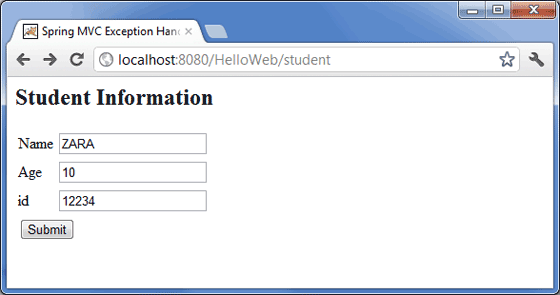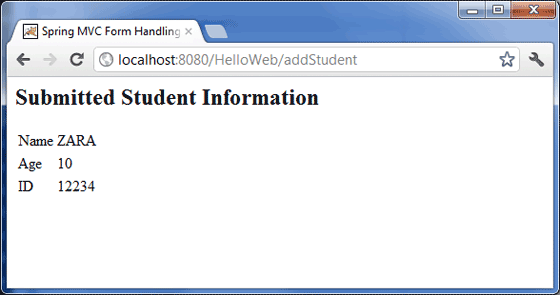Spring MVC - Esempio di casella di testo
L'esempio seguente mostra come utilizzare le caselle di testo nei moduli utilizzando il framework Spring Web MVC. Per cominciare, disponiamo di un IDE Eclipse funzionante e atteniamo ai seguenti passaggi per sviluppare un'applicazione Web basata su modulo dinamico utilizzando Spring Web Framework:
| Passo | Descrizione |
|---|---|
| 1 | Crea un progetto con un nome HelloWeb sotto un pacchetto com.tutorialspoint come spiegato nel capitolo Spring MVC - Hello World Example. |
| 2 | Crea una classe Java Student, StudentController nel pacchetto com.tutorialspoint. |
| 3 | Crea una visualizzazione dei file student.jsp, result.jsp nella sottocartella jsp. |
| 4 | Il passaggio finale consiste nel creare il contenuto dei file sorgente e di configurazione ed esportare l'applicazione come spiegato di seguito. |
Student.java
package com.tutorialspoint;
public class Student {
private Integer age;
private String name;
private Integer id;
public void setAge(Integer age) {
this.age = age;
}
public Integer getAge() {
return age;
}
public void setName(String name) {
this.name = name;
}
public String getName() {
return name;
}
public void setId(Integer id) {
this.id = id;
}
public Integer getId() {
return id;
}
}StudentController.java
package com.tutorialspoint;
import org.springframework.stereotype.Controller;
import org.springframework.web.bind.annotation.ModelAttribute;
import org.springframework.web.bind.annotation.RequestMapping;
import org.springframework.web.bind.annotation.RequestMethod;
import org.springframework.web.servlet.ModelAndView;
import org.springframework.ui.ModelMap;
@Controller
public class StudentController {
@RequestMapping(value = "/student", method = RequestMethod.GET)
public ModelAndView student() {
return new ModelAndView("student", "command", new Student());
}
@RequestMapping(value = "/addStudent", method = RequestMethod.POST)
public String addStudent(@ModelAttribute("SpringWeb")Student student,
ModelMap model) {
model.addAttribute("name", student.getName());
model.addAttribute("age", student.getAge());
model.addAttribute("id", student.getId());
return "result";
}
}Ecco, il primo metodo di servizio student(), abbiamo passato uno Studentobject vuoto nell'oggetto ModelAndView con il nome "comando", perché il framework spring si aspetta un oggetto con il nome "comando", se stai usando <form:form>tag nel file JSP. Quindi, quando viene chiamato il metodo student (), ritornastudent.jsp view.
Il secondo metodo di servizio addStudent() verrà chiamato contro un metodo POST su HelloWeb/addStudentURL. Preparerai il tuo oggetto modello in base alle informazioni inviate. Infine, verrà restituita una vista "risultato" dal metodo del servizio, che risulterà nel rendering di result.jsp
student.jsp
<%@taglib uri = "http://www.springframework.org/tags/form" prefix = "form"%>
<html>
<head>
<title>Spring MVC Form Handling</title>
</head>
<body>
<h2>Student Information</h2>
<form:form method = "POST" action = "/HelloWeb/addStudent">
<table>
<tr>
<td><form:label path = "name">Name</form:label></td>
<td><form:input path = "name" /></td>
</tr>
<tr>
<td><form:label path = "age">Age</form:label></td>
<td><form:input path = "age" /></td>
</tr>
<tr>
<td><form:label path = "id">id</form:label></td>
<td><form:input path = "id" /></td>
</tr>
<tr>
<td colspan = "2">
<input type = "submit" value = "Submit"/>
</td>
</tr>
</table>
</form:form>
</body>
</html>Qui stiamo usando <form:input />tag per eseguire il rendering di una casella di testo HTML. Ad esempio:
<form:input path = "name" />Renderà il seguente contenuto HTML.
<input id = "name" name = "name" type = "text" value = ""/>result.jsp
<%@taglib uri = "http://www.springframework.org/tags/form" prefix = "form"%>
<html>
<head>
<title>Spring MVC Form Handling</title>
</head>
<body>
<h2>Submitted Student Information</h2>
<table>
<tr>
<td>Name</td>
<td>${name}</td> </tr> <tr> <td>Age</td> <td>${age}</td>
</tr>
<tr>
<td>ID</td>
<td>${id}</td>
</tr>
</table>
</body>
</html>Una volta che abbiamo finito di creare file sorgente e di configurazione, esporta la tua applicazione. Fai clic con il tasto destro sulla tua applicazione, usaExport → WAR File opzione e salva il file HelloWeb.war file nella cartella webapps di Tomcat.
Ora, avvia il server Tomcat e assicurati di essere in grado di accedere ad altre pagine web dalla cartella webapps utilizzando un browser standard. Prova un URL -http://localhost:8080/HelloWeb/student e vedremo la seguente schermata se tutto va bene con l'applicazione Web Spring.

Dopo aver inviato le informazioni richieste, fare clic sul pulsante di invio per inviare il modulo. Dovremmo vedere la seguente schermata, se tutto va bene con l'applicazione Web Spring.
